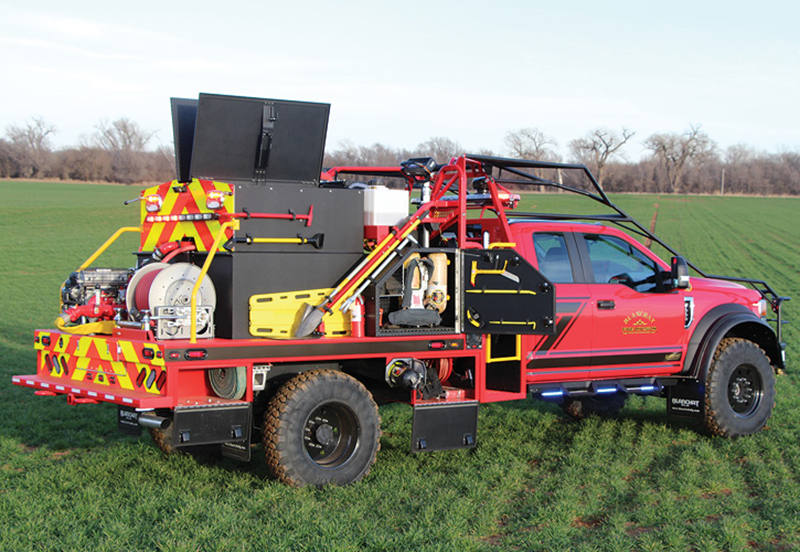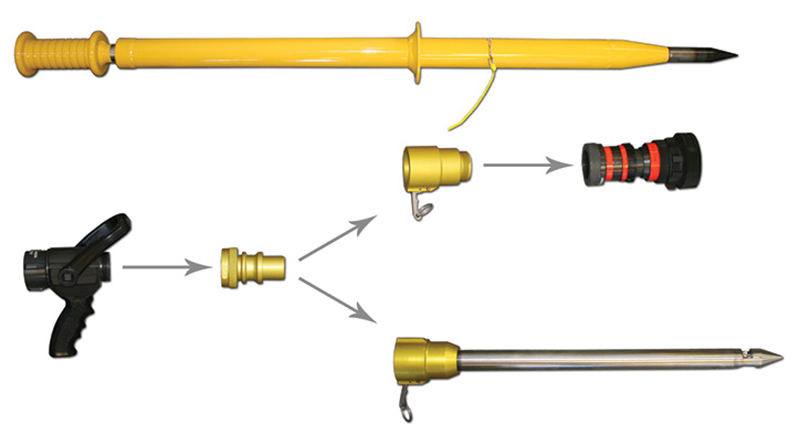Manufacturer’s spotlight Chris McLoone
Greg Blanchat originally thought he was going to take over the family farm, but when he manufactured his own plow, which garnered requests from others for similar equipment, he got into manufacturing. A close call as a firefighter led to him designing the behind-the-cab attack position for wildland firefighting. Editor in Chief Chris Mc Loone recently spoke with Blanchat about his company and what drives him.

CM: Please provide a brief history of Blanchat Manufacturing.
GB: I was going to be a farmer. I always wanted to be a fighter pilot, but my eyes weren’t good enough. I’m the oldest son of four kids, and I was going to be the one who took over the farm. I got into manufacturing because I couldn’t afford my equipment. So, I built a plow, and others said, “Why don’t you do one for me?” That got me into manufacturing equipment.
1988 is when I started in fire. What happened is I was on the fire department for about two years, and I got thrown off a truck and almost killed. I basically quit the fire department over that. That’s when I came up with the behind-the-cab fire attack position. When I got on the fire department, we rode on the front of those trucks—great place to fight a fire but first one in a wreck. Very dangerous, extremely dangerous. What makes it so bad is when you’re on the front of the truck, it isn’t the collision with anything, it’s the springboard action. If that front wheel hits a bump and you’re sitting in front of that front wheel, you multiply it. So when that front wheel comes up 3 inches, the front end of that truck’s coming up 5 to 6 inches. So, you’re springboarding. What makes the behind-the-cab fire attack position so much safer is if that front end comes up 3 inches, the center only comes up maybe an 1½ inches. So you’re decreasing the springboard action.
So, 1988 is when I built my first truck. My fire chief said, “You need to start building these.” I said, “I don’t have time to build these. I am so busy building everything else.” Well, the next year I started doing it. And then I decided, and I think it was ‘94 or ’96, I was going to go 50% fire and 50% agriculture. Today, it’s probably 99.9% fire.

1 The Chaparral is a wildland, first response, quick-attack truck. (Photos courtesy of Blanchat Manufacturing.)

CM: Talk about the company’s motto: “No matter what, there is always a better way.”
GB: No matter what, there’s a better way to build this truck. What I love to do is talk to people who had my truck, and I say, “What would you change on this truck?” They will say, “Well, I would change nothing.” I say, “Let me rephrase this question to you: You haven’t bought this truck, but you have all the knowledge of what this truck does and how it does it. Now, what would you change? How would you do it?” I changed a truck one time over a five-year-old kid. This kid was five years old, and he was sitting in the behind-the-cab fire attack position, and he says, “Look—I can fall out.” I said, “You’re right you can. But, I guarantee you: The next one you see, you won’t.” And, the chief asked why I was saying that. He said, “He won’t ever be on that truck in a fire.” I said, “Yeah, but he’s a small body. And, a small body person could.” That got my attention. I don’t get beat on safety.

2 Blanchat’s BEAST allows firefighters to safely make an interior attack from the outside.

CM: Talk about some of Blanchat’s other innovations that some might not know about.
GB: I would say the number one thing is the BEAST. BEAST stands for Blanchat External Attack Structure Tools. Basically I can put out 95% of a fire from the outside of a structure or a barn or whatever it is. What got me started on this is I got disoriented in a basement. Basically, it is a piercing nozzle. What pierces is a slide hammer. I can drive that through a brick wall. The way the nozzle is carried is just like a pistol grip nozzle. The only difference is I unscrew the nozzle and I put an adapter on there. It’s a quick-release adapter. The quick-release adapter is a two-latch cam lock. It’s an agriculture thing. I made it into a single-cam. How I did the single cam is to lengthen the tip on it because you can trash it if you break it off. You can go down to your local farm store and buy a new one. We put the end so you can slip off the fog nozzle. When you slip off the fog nozzle, now you’ve got a straight bore nozzle. If you’re running CAFS, you have an 11/8 inch. If you’re running an 1¾-inch line, you usually run ¾ inch, so that turns it into a ¾-inch straight bore nozzle. That round straight bore nozzle, when you poke a hole into a wall, you can take that straight bore nozzle and shove into that hole and open that nozzle up and give it about a five-second burst, which will go clear across the room. Then you pull it out, you clip on the wall nozzle. The wall nozzle is about a 24-inch pipe. At the end of this pipe, there’s a point on it that also creates a dovetail. The dovetail is 90 degrees off that pipe. And, that dovetail will reach 50 feet. At the opposite side of the 90-degree, we put a second dovetail. It sits at 45 degrees, so if you put that in there, you spin it back and forth, you get straight up 40 to 50 feet and you then go at an angle about 40 or 50 feet.

CM: Are there any new products on the horizon readers should be on the lookout for?
GB: Oh, I’m always doing something. The the two things right now in the pipeline, but aren’t really out there, I’m starting to push more are the Blanchat CAFS and the BEAST. It’s word of mouth. You don’t even see it or hear of it unless somebody’s told you about it.

CM: What keeps you up at night?
GB: My firefighters—my firefighters are number one. You will not find anybody who pays more attention to safety on a truck than me. My sales force is my people and all my trucks. I’m a little guy, and I like being a little guy because I can change instantly if we find a better way. Every time I went out and fought a fire or went somewhere, I came back and changed the truck. We have to rely on this truck. That’s part of my success.

